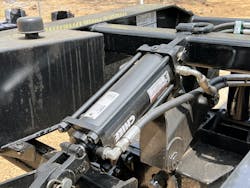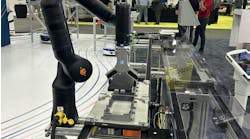Integration of sensors and other electronics is not new to the hydraulics industry, but it has grown in recent years as technology has advanced and become more affordable. By integrating electronics, increased precision can be achieved as well as better monitoring of performance and potential maintenance – all of which can help end use customers be more productive and efficient.
Power & Motion spoke with Ken Baker, CEO of Bailey International, about the increasing use of electronic components within hydraulic systems as well as his expectations for the market in 2024.
*Editor’s Note: Questions and responses have been edited for clarity.
Power & Motion (P&M): What trends or market factors do you feel had the largest impacts on hydraulic component and system designs in 2023? Please explain what those trends are and how specifically they impacted the design of hydraulics.
Ken Baker (KB): The trend we've seen this year, and I think it's heading into 2024, is a general market slowdown. The market rebound from COVID operated at a torrid pace; we are starting to see that roll off. Our prediction for our business, and I think the market in general is a soft landing; I tend to be in the soft-landing camp. But a lot of people are still predicting a mild recession. I think in the hydraulics market you see varied opinions, but our opinion is definitely that it will be a soft landing. We're still projecting slight growth for the year, and so we want to want to hold to that and drive our teams to succeed in that way. I think that's the biggest market impacts that we’re seeing.
In terms of changing market conditions, certainly over the last 2 or 3 years, availability of components was a big driver; if you had components, you could almost write your own ticket for the sales. I think we're seeing that normalize now. I think the availability of product, both imported as well as domestic production, with that slowdown, has finally caught up. From a market perspective that has a big impact as well.
In terms of technology, I think the biggest change that we've seen is definitely a continued move toward electrification in our hydraulic circuits. I don't foresee replacement of the hydraulics by electrical products simply because of the physics [involved]. But we do see more sensors, more controls, more electrohydraulic valves, and more monitoring of the system. And we're seeing that move from the high tier ones down into the middle market, and even some of the smaller players as they work to stay competitive.
P&M: How have you seen hydraulic component and system designs evolve in recent years?
KB: We produce in our Knoxville and Montreal facilities a lot of hydraulic cylinders. We're seeing a lot more cylinder production with sensors for linear positioning. We're also keeping our eye on additional technologies that may ease the burden of the use of linear positioning. We see…increased integration of components. We offer a lot of handles and joysticks, and now we're seeing people that want more integrated controllers and more complete assemblies. I think that couples well with the overall electrohydraulic systems.
P&M: What are some of the key features or performance attributes your company is working to include with its hydraulic components and systems, or for which customers are asking?
KB: I’ll highlight two things – I mentioned the linear positioning, the accuracy of that is key. A lot of people want a highly accurate system, especially for safety and service purposes. We also see an increased desire to be more of a one-stop shop for electronics. That includes sensors; we’ve never had a strong sensor business but we’re seeing a lot more requests from our customers to do that so we’re developing both sources and looking inquisitively as well to see if there’s some good sensor offerings we can bring to our customers.
P&M: Are you able to expand a little on that, what are some of types of sensors or things customers are wanting to utilize sensors for in their hydraulic systems?
KB: The biggest is position sensing, both for safety reasons – tilt sensors as well as general equipment positioning to make sure they know where the position is. We’ve got an experiment underway at our company to look at inertial sensors replacing some of the direct technology so you can look holistically at where a piece of equipment…has moved. It could be some simpler options; we are seeing those kinds of sensors come into play in addition to the standard temperature [and] pressure sensors that are normally included with a hydraulic circuit. People are looking for more of a collection of sensors available from one company, either through distribution or through manufacturing.
READ MORE - Hydraulic Cylinder Sensors Aid Pile Driver Accuracy
P&M: How much, if at all, are you seeing electronic alternatives taking the place of hydraulic components or systems? Can you offer some examples, and how you possibly see this trend progressing?
KB: We haven’t run into examples where electric products are taking the place of hydraulics, mainly in the equipment functioning. Again, the physics of hydraulics makes it the most compact power source available. The knock on hydraulics is that it’s slow, it takes awhile to build up the pressure but electric devices can’t generate the same levels of forces, at least without a lot of gearing and overhead products that make it cost prohibitive. You’re seeing electrification take control more in the drive circuits, a lot of that transition is occurring beyond electric vehicles now in on- and off-road products. I think those things are starting to become more common. And then the electric drive for the hydraulic motor force generation through the pumping for the hydraulic circuit is occurring. But it’s not necessarily replacing the work end of the hydraulic circuits that we’re seeing.
P&M: So would you say the work end is where there is going to continue to be longevity for hydraulics?
KB: I do. Even in the drive circuits where you have the slower speed, higher torque requirements, electric motors can generate very higher torque, but the torque rolls off very quickly where a hydraulic circuit or hydraulic motor in those drives can continue to drive. But I think the electrification of those drive systems will continue simply because of the push to get out of other gasoline or diesel driven motors.
P&M: Beyond sensors, are you seeing a greater integration of other electric or electronic components with hydraulics, and more hybrid or electrohydraulic systems?
KB: I would say we’re exploring an area right now, and that is more around maintenance items, looking at hydraulic motors and hydraulic pumps that have a spinning motion [and] including sensors that could be used for maintenance. Less for safety in that case, just for maintenance so that you can understand the revolutions a pump has seen, or the revolutions a motor has seen, again, for that service function. Those kinds of things we're exploring, I don't see a lot of products like that on the market. And so you know, I think it could be a new area for sensors. So, we're excited about that.
And again, we are seeing a number of different technologies in the linear positioning sensor that we're trying to explore, to make sure that we try to stay on the cutting edge of that technology availability. There are new technologies that are being developed that we want explore as [they] come up.
READ MORE - Sensors and Software in Motion Control: Key Benefits to Consider
P&M: Do you foresee any new trends or market factors impacting hydraulic designs in the coming year or years? If so, what are those and what impact will they have?
KB: As I mentioned earlier, I think the biggest trend is just that the technology requirements are pushing into the lower market segments to the small- to mid-range manufacturer. Where the very large manufacturers have had those capabilities to stay competitive, a lot of those small- to mid-size players have [had] to become more technically adept. They're leaning on their suppliers for more technology support. Our company does not do systems engineering, but people are looking for increased technical availability and [participation] in their systems engineering, or working with a systems integrator that they have a relationship with to make sure that we can offer the right technical knowledge them to make the right decisions. Those are trends that I definitely see – that movement down into the market into smaller players as well as a requirement for us to be more technically adept.
P&M: Are there any economic/market factors you are concerned could negatively impact the hydraulics industry in the coming year?
KB: Nothing along the design front that I see. Again, I think the market indications are that we are slowing down; we continue to watch that. We're more optimistic than some people in the industry in general, but we are seeing it slow down. And I think that's going to be the key to watch. We're trying to keep a careful eye on our inventory, because you can get ahead and inventory too much but you don't want to be caught short when you see the rebound coming. We're expecting a rebound to really take hold in about 18 months. So we should see the next 12-18 months starting to go back up again.
P&M: Do you possibly see any benefits or opportunities with this slowdown that is coming, maybe an opportunity to invest in your business or make supply chains more robust?
KB: Our company, organically [and] our ownership group, are very bullish in these times when you see things slowing down at expanding staff where you can find some key players that you want to get particularly in the sales or marketing fronts. We're…still continuing to grow our sales force aggressively to make sure that we're positioned well for that rebound. We are making a large capital expansion in our domestic production facilities, domestic being North America. We have facilities in Montreal, as well as in Knoxville, TN, and we have made a significant investment in both facilities to continue to grow and expand our capacities for hydraulic cylinder, power unit, manifold production as well as limited valve and assembly production there. Our Knoxville facility is up about 25% of capacity, and more to go, and our Montreal facility is up about 20% so far, and we continue to expand that capability.
We have made those types of investments and we're also making a big investment in our marketing group. We believe that our message in the marketplace needs to be clearer and needs to be more broadly shared so we're making the investment in marketing over the next 2 years to make that message more available to our customers [about] the breadth of what we do.
P&M: How do you see the hydraulics market in general performing in 2024 and beyond? Are there certain segments of the market you see that might have better opportunities than others?
KB: The strongest market segment that we see today is non-residential construction. Those types of projects are helped both with government spending, which is really active right now, as well as the lead time for the commercial sector. Once they get a project approved and started, that can be a nine-to-18-month lifecycle. It's very difficult and costly to end those kinds of projects mid-cycle, so commercial and government non-residential construction is very strong right now.
Agriculture and forestry both are weaker. We see them rebounding. Agriculture we see is weaker because of the significantly higher production of crops. You don't know how that goes year over year, but that should normalize and the pricing [will] rebound, hopefully – farmers don't spend money if they don't make money [but] we see that rebounding. The forestry market should rebound, we hope, with the recovery in residential housing construction. Housing needs lumber and lumber needs forestry, that’s the relationship we see there.
And then transportation sectors, I think they're going to follow the macro-economics, they're flat right now. And as the macro-economy bounces back over the next 12-18 months, we would expect transportation to pick up. Transportation’s not down in our market but we see a flat line right now.





